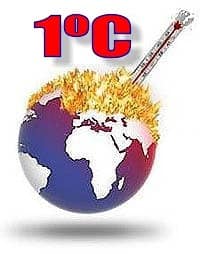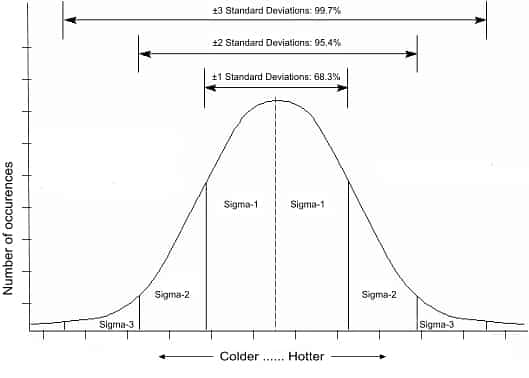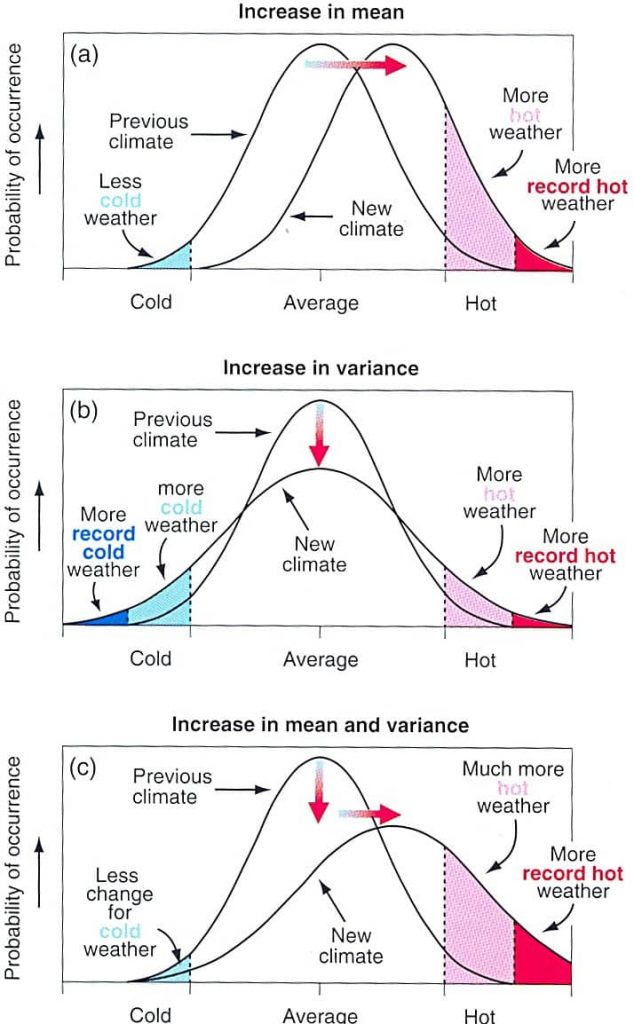 PART ONE: HOW BAD CAN ONE DEGREE BE?
PART ONE: HOW BAD CAN ONE DEGREE BE?
by Ian Angus
Climate negotiators have adopted 2°C as the maximum increase that can be permitted if dangerous consequences are to be avoided. Many scientists, and the governments of many small countries, argue that 2° is too high – that the limit should be 1.5°. But according to climate experts, if current trends continue, the average temperature by the end of this century will definitely be 3.5° degrees above pre-industrial levels, and there is a strong possibility that the increase will be more than 4 degrees.[1]
That doesn’t sound like much. When I woke on a recent August morning, the temperature outside was 19°, and by noon, it was 25°. That’s a six degree jump in five hours or so, a pretty common experience in summer in the part of the Northern Hemisphere where I live. So why would we worry about an increase of 2 or even 4 degrees by 2100? Mention that at a party in my neighborhood, and someone is sure to say that they’d be very happy if our Canadian winters were 4 degrees warmer!
It may be counter-intuitive, but 4 degrees is actually a big jump. During the last ice age, when kilometers of ice covered areas as far south as present-day Chicago, the average global temperature was only 5 degrees cooler than today.
It’s important to remember that average global temperatures conceal substantial variations in time and place. For example, the atmosphere is consistently cooler over oceans, but a 4 degree average global increase could mean a 6 degree or more increase on land and a 16 degree increase in the Arctic. In the tropics, the increase would likely be less than 4 degrees, but that smaller shift would go from very hot to extremely hot.
There is more to global warming than average thermometer readings: temperature change can cause dramatic shifts in weather patterns, biodiversity, and much more. Unless radical changes are made, the Anthropocene will be marked not just by warmth, but by a new climate regime, very different from the 11,700 years of Holocene stability. That isn’t just speculation: the transition is well under way.
To begin, a necessary digression:
| Standard deviation and sigma events
Scientists calculate the Standard Deviation to measure how much a set of observations is spread out from the average, or mean. If the data is normally distributed, about 68% of the observations will be within one standard deviation on either side the mean, and about 95% will be within two standard deviations. Anything beyond that will be possible, but rare. A graph of average July temperatures over many years might look like this.
The bell curve would be wider if the range of temperatures was greater, narrower if the range was smaller, and the width of each standard deviation would change similarly. The mathematical symbol for standard deviation is the Greek letter sigma (σ). Observations that are more than two standard deviations from the mean are called Sigma-3 events. Much rarer events are Sigma-4, Sigma-5, and so on. Temperatures in the Sigma-3 band will normally occur less than once a century, and those in the Sigma-5 band no more than once in several million years. |
Loading the climate dice
In September 2012, the prestigious journal Proceedings of the National Academy of Sciences published a study that examined how global warming to date has affected global climate. The results were remarkable: authors James Hansen, Makiko Sato and Reto Ruedy showed that the frequency of extreme temperatures, particularly in the summer, has “changed dramatically in the past three decades.”[2]
As a baseline, Hansen, Sato and Ruedy examined the period 1951-1980, before rapid global warming began and while the climate was still within the long-term Holocene range. They graphed average monthly temperatures for small (250km x 250km) areas covering the entire globe, and calculated the Standard Deviation for each measurement, to show how much year-to-year variation there was. As expected, the temperatures didn’t vary very much — almost every temperature point was within two Standard Deviations of the mean – Sigma-1 or Sigma-2. They then did the same for 1981-2010, and compared the results.
Since we know that the Earth was warmer, on average, in 1981, it’s not surprising that the graphs have shifted to the right – the mean is warmer, and so are individual temperatures. The shocking discovery is that the graphs have also changed shape, because the amount of variation has increased.
Hansen, Sato and Ruedy write:
“The distribution of seasonal mean temperature anomalies has shifted toward higher temperatures and the range of anomalies has increased. An important change is the emergence of a category of summertime extremely hot outliers, more than three standard deviations (3σ) warmer than the climatology of the 1951–1980 base period. This hot extreme, which covered much less than 1% of Earth’s surface during the base period, now typically covers about 10% of the land area.”[3]
Here’s what happened:
| Hotter and more extreme
This schematic, from the IPCC’s 2001 report on the scientific basis for climate change, shows the effect on extreme temperatures when (a) the mean temperature increases, (b) the variance increases, and (c) when both the mean and variance increase. James Hansen’s 2012 paper shows that (c) has in fact happened, producing weather that is simultaneously hotter and more prone to extremes. |
In practice, this means that extreme heat waves – Sigma-3 events, which were virtually non-existent in 1951-1980 – have become increasingly frequent. For example:
- Europe, 2003: The hottest summer in at least 500 years killed over 70,000 people.
- Russia, 2010: The hottest summer since 1500 caused 500 wildfires near Moscow and cut grain harvests by 30%. 56,000 people died.
- USA, 2011: The most extreme July heat and drought since 1880, in Texas and Oklahoma. Damage estimated at $13 Billion
Referring specifically to those events, Hansen, Sato and Ruedy write “We can say with high confidence that such extreme anomalies would not have occurred in the absence of global warming.”[4]
They compare the climate to colored dice. In the baseline decades, two sides were red for hot, two were blue for cold, and two were white for near-average – the odds of any month being red, blue or white were equal. Now, the dice have been rigged: four sides are red, so hot comes up more often. But the analogy is breaking down, because we have to add a new category – extremely hot.
In a commentary, climatologists Thomas Karl and Richard Katz describe this paper as a “simple and elegant” demonstration that “we are now more than 10-fold as likely to endure an extremely hot summer than we were in the decades 1951-1980.”
“Hansen et al. have made the case that we are no longer waiting for evidence of global warming. It is clearly here now, affecting a wide variety of weather and climate events, and it will continue to grow as we burn more fossil fuels. …even the apparently normal distribution of temperature can display non-normal behavior, and this can lead to extremes of even greater magnitude than might otherwise be expected.” [5]
In short, an average temperature increase of less than 1 degree has already disrupted the global climate system, pushing the Earth’s climate out of Holocene conditions – and this is only the beginning. As Hansen, Sato and Ruedy warn, even 1 degree more could have devastating consequences: “In that case, the further shifting of the anomaly distribution will make Sigma-3 anomalies the norm and Sigma-5 anomalies will be common.”[6]
Please use the Comments box below for replies, suggestions and (if necessary) corrections.
See also:
- Anthropocene heat, part two: Four degrees of devastation
- Anthropocene heat, part three: A one way street to climate hell
Footnotes
[1] Potsdam Institute for Climate Impact Research and Climate Analytics. Turn Down the Heat: Confronting the New Climate Normal (pdf). World Bank, Washington DC: 2014. 5
[2] James Hansen, Makiko Sato, and Reto Ruedy. “Perception of climate change.” PNAS 109, no 37, September 11, 2012. E2415-E2423
[3] Ibid
[4] Hansen, Sato, Ruedy. “Perception”
[5] Thomas R. Karl and Richard W. Katz. “A new face for climate dice.” PNAS 109, no 37, September 11, 2012. 14720-14721
[6] Hansen, Sato, Ruedy. “Perception.”





Thank you for writing and publishing this. An excellent bit on statistics that is under-appreciated.
Thanks for great article!
Editing note here. Delete the words in caps:
In Part Two, to be published later this month, I will discuss what recent research tells us about how IN WHICH the Anthropocene’s new climate regime could develop in coming decades, with and without emission reductions. In the meantime, please use the Comments box below for replies, suggestions and (if necessary) corrections.
Ted, thanks for catching that. I’ve fixed it.